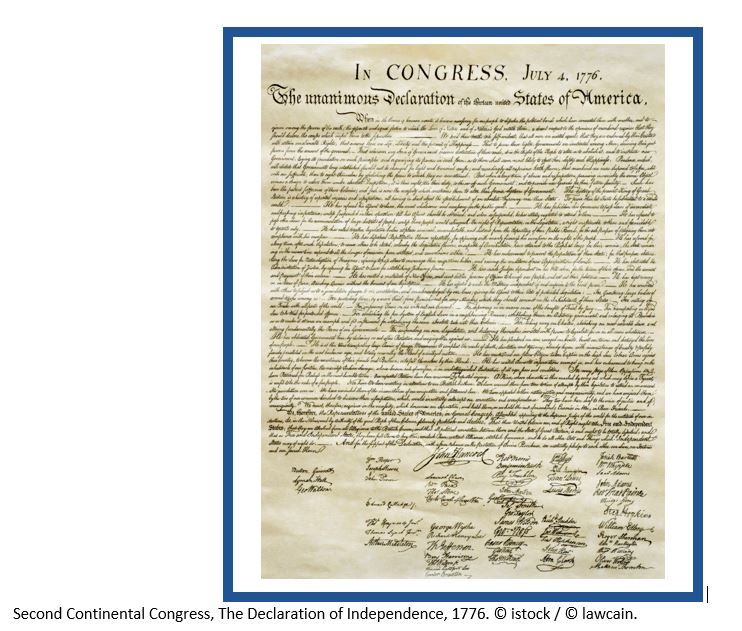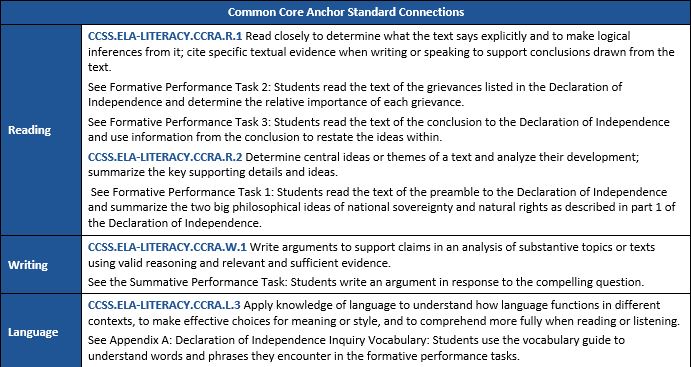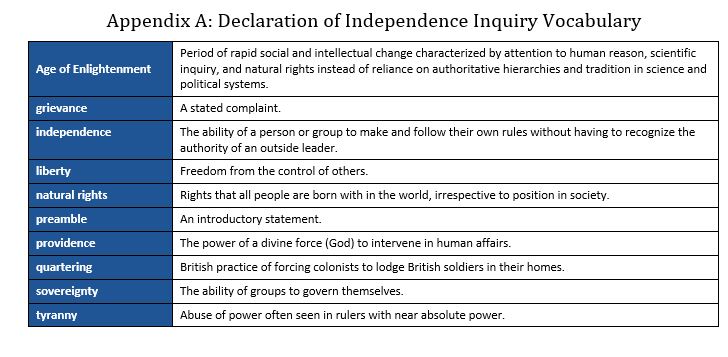5th Grade Declaration of Independence Inquiry
Why Do Countries Declare Independence?
Download Entire Inquiry Here
Why Do Countries Declare Independence?
Download Entire Inquiry Here
Staging the Compelling Question: Why do countries declare independence?
- Source A: Eric Langhorst, a fabricated breakup letter from the American colonists to King George III, “Teaching the Declaration of Independence as a Break Up Letter - Podcast and Video,” Speaking of History blog, October 30, 2008. Used by permission of Dr. Eric Langhorst. http://speakingofhistory.blogspot.com/2008/10/teaching-declaration-of-independence-as.html.
- Break up letter in Word
Supporting Question 1- What are the two big philosophical ideas in the Declaration of Independence?
- Source A: Second Continental Congress, part 1 of the Declaration of Independence, “Preamble,” July 4, 1776
Supporting Question 2- What grievances did the colonists have with King George III?
- Source A: Second Continental Congress, part 2 of the Declaration of Independence, “Grievances,” July 4, 1776.
Supporting Question 3- How does the Declaration of Independence make an argument for independence?
- Source A: Second Continental Congress, part 3 of the Declaration of Independence, “Conclusion,” July 4, 1776
Supporting Question 4- How do declarations of independence from other places in the Western Hemisphere compare with the United States Declaration of Independence?
- Source A: Table, dates and locations of independence declarations in Latin America, 1776–1838
From whom: France
When: 1791–1803
Key leader: Toussaint L’Overture
Important facts
- Haiti’s independence movement was the largest and most successful slave rebellion in the Western Hemisphere.
- Haiti was the second nation in the Western Hemisphere to win independence from its European colonizer.
- The Haitian independence movement was influenced by the French Revolution (1789) and the Declaration of the Rights of Man.
- Interesting facts:
- Haiti won independence when Napoleon Bonaparte ruled France.
- Haitian independence led indirectly to the Louisiana Purchase.
- The French language is still spoken in Haiti today.
- The country was named Saint-Domingue when it was under French control.
- At the time of independence, enslaved persons outnumbered owners ten to one.
- Created for the New York State K–12 Social Studies Toolkit by Binghamton University, 2015.
- Venezuela Declaration of Independence (excerpts), July 5, 1811
Original Translation
Notwithstanding our protests, our moderation, generosity, and the inviolability of our principles, contrary to the wishes of our brethren in Europe, we were declared in a state of rebellion; we were blockaded; war was declared against us; agents were sent amongst us, to excite us one against the other, endeavouring to take away our credit with the other Nations of Europe, by imploring their assistance to oppress us….
Like all the other nations of the world, we are free, and authorised not to depend on any other authority than our own, and to take amongst the powers of the earth the place of equality which the Supreme Being and Nature assign to us.
We, therefore, in the name and by the will and authority which we hold from the virtuous People of Venezuela, DO declare solemnly to the world, that its united Provinces are, and ought to be, from this day, by act and right, Free, Sovereign, and Independent States; and that they are absolved from every submission and dependence on the Throne of Spain.
Public domain. Venezuelan Declaration of Independence and Constitution (Longman and Co., 1812). Rice University Digital Scholarship Archive.
Summary of Venezuela’s Independence Movement
From whom: Spain (and later, from Gran Colombia)
When: 1811–1823
Key leader: Simón Bolívar
Important facts:
- France’s conquest of Spain in 1808 lead to the crumbling of the Spanish empire in the Western Hemisphere.
- Venezuela’s quest for independence was influenced by Enlightenment ideas and revolutions in the United States and France.
- Venezuela was the first region in South America to declare independence from Spain.
- The Creoles resented high taxes, second-class status, and corruption.
- Interesting Facts:
- Francisco de Miranda (a friend of Alexander Hamilton and Catherine the Great) launched a failed independence effort in 1806.
- Before independence in 1811, Venezuela was part of the Spanish Viceroy of New Granada.
- Venezuela’s civil war was between supporters of Spain and supporters of the revolutionaries.
- Venezuela became part of Republic of Gran Colombia in 1819 until it fell apart in 1830.
-
Created for the New York State K–12 Social Studies Toolkit by Binghamton University, 2015.
- Mexico Declaration of Independence, September 28, 1821
Declaration of the independence of the Mexican Empire, issued by its Sovereign Junta, assembled in the Capital on September 28, 1821.
The Mexican Nation, which for three hundred years had neither had its own will, nor free use of its voice, leaves today the oppression in which it has lived.
The heroic efforts of its sons have been crowned today, and consummated is an eternal and memorable enterprise, which a spirit superior to all admiration and praise, out of love and for the glory of its Country started in Iguala, continued, and brought to fruition, overcoming almost insurmountable obstacles.
Restored then this part of the North to the exercise of all the rights given by the Author of Nature and recognized as unalienable and sacred by the civilized nations of the Earth, in liberty to constitute itself in the manner which best suits its happiness and through representatives who can manifest its will and plans, it begins to make use of such precious gifts and solemnly declares by means of the Supreme Junta of the Empire that it is a Sovereign nation and independent of old Spain with which henceforth it will maintain no other union besides a close friendship in the terms prescribed by the treaties; that it will establish friendly relationships with other powers, executing regarding them whatever declarations the other sovereign nations can execute; that it will constitute itself in accordance to the bases which in the Plan of Iguala and the Treaty of Córdoba the First Chief of the Imperial Army of the Three Guarantees wisely established and which it will uphold at all costs and with all sacrifice of the means and lives of its members (if necessary); this solemn declaration, is made in the capital of the Empire on the twenty-eighth of September of the year one thousand eight hundred and twenty-one, first of Mexican Independence.
Public domain. Source: Wikipedia, https://en.wikipedia.org/wiki/Declaration_of_Independence_of_the_Mexican_Empire?CFID=4854641&CFTOKEN
=35833133.%20Accessed%20on%206/8/15.
Summary of Mexico’s Independence Movement
From whom: Spain
When: 1810–1821
Key leaders: Father Miguel Hidalgo, Father Jose Maria Morelos, and Augustin de Iturbide
Important facts:
- Peasants and miners were an important part of the revolutionary army.
- The revolutionaries were inspired by the revolutions in Haiti and the United States.
- Interesting facts:
- The move to independence was set in motion after Napoleonic France conquered Spain in 1808.
- Priest Miguel Hidalgo issued the Cry of Dolores (a declaration of war) in 1810.
- Spain attempted to reconquer Mexico on two occasions between 1821 and 1829.
- Iturbide’s rule did not last long. He was overthrown in 1824 and Mexico became a republic.
- Mexico lost California in 1848 (the same year gold was discovered) after losing the Mexican American War
-
Created for the New York State K–12 Social Studies Toolkit by Binghamton University, 2015.
Public domain. Source: Wikimedia Commons, http://commons.wikimedia.org/wiki/File:Non-Native_Nations_Claim_over_NAFTA_countries_1818.png and http://commons.wikimedia.org/wiki/File:Non-Native_Nations_Claim_over_NAFTA_countries_1824.png.


Appendix B: Additional Resources for Teaching this Inquiry
- DOI Road Trip, “Reading of the Declaration of Independence.” YouTube, August 27, 2009. Dramatic reading of the Declaration of Independence from Mel Gibson, Michael Douglas, Kathy Bates, Kevin Spacey, Whoopi Goldberg, Edward Norton, Renée Zellweger, Ming Na, Winona Ryder, and Benicio Del Toro, https://www.youtube.com/watch?v=ETroXvRFoKY.
- Stephen E. Lucas, “The Stylistic Artistry of the Declaration of Independence.” National Archives, 1989. http://www.archives.gov/exhibits/charters/declaration_style.html